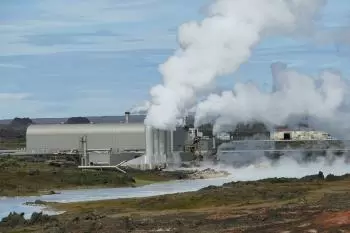
Geothermal energy is useful for obtaining heat energy. In a small installation it is used to supply hot water and heating, for example. However, there are geothermal power plants that harness underground heat to generate high-temperature steam and generate electricity.
The term geothermal energy is the energy that can be recovered from geothermal reservoirs located in the interior of the Earth and used for energy or other purposes.
Geothermal energy is considered a renewable and sustainable energy source.
Greenhouse gas emissions from geothermal power plants average 45 grams of carbon dioxide per kilowatt-hour of electricity, or less than 5% of the amount from conventional coal power plants.
How to convert geothermal energy into power?
One of the most used applications of geothermal energy is the generation of electricity. The choice of technology for power production depends on the type of geothermal reservoir.
Further steam treatment is the same as in a conventional power plant: the steam is fed to a steam turbine, which drives the rotor of an electrical generator. After the steam turbine enters the condenser, it is condensed to return the water thus obtained to the geothermal source.
Geothermal energy uses steam to drive the steam turbine. Steam (wet or dry) can be obtained directly from the reservoir, and it can also be produced artificially in hot, dry rocks, so-called advanced geothermal systems.
In beds with lower fluid temperatures, steam to drive the turbines is obtained indirectly by heating the working fluid with a lower boiling point than the boiling point of water.
The steam turbine is connected to an electrical generator that will convert the circular motion into electrical energy.
Types of geothermal plants
Geothermal power plants can be divided into three basic types:
-
Dry steam plants.
-
Evaporation plants (simple and double).
-
binary plants.
Dry steam geothermal power plants
Dry steam plants are the first type of geothermal power plants to reach commercial status.
The steam can be fed directly to the turbine from the production well and discharged to the atmosphere after expansion. Superheated steam is generally generated and contains only small amounts of other gases.
Such a direct condensation cycle is the simplest and cheapest option to produce electricity. They are used in cases where the steam contains a large proportion of non-condensing gases.
Evaporative geothermal power plants
Evaporative geothermal power plant technology is applied in dominant water beds. The energy in this case is pressurized water. Since the pressure in the well is generally lower than the pressure in the well, the water under pressure in the well flows to the surface.
As a result of the pressure drop, a certain portion of the liquid evaporates, and the well produces hot water and steam at the same time.
The double evaporation plant is an improvement over the single evaporation plant, providing 15-25% more production.
Binary cycle geothermal power plants
Binary cycle geothermal power plants are the closest to conventional thermal power plants (fossil or nuclear fuels).
The working fluid is inside a closed cycle. The selected working fluid receives heat from the Earth through the geothermal fluid, evaporates, expands in the turbine, condenses and returns to the evaporator by means of a feed pump.
Binary plants enable the conversion of geothermal heat into power from low-temperature hot water reservoirs with temperatures above 85 degrees Celsius.
The use of binary plants has been improved with the introduction of Kalina technology . A mixture of water and ammonia evaporates within a finite temperature range, producing two-component vapor (for example, 70% ammonia and 30% water). In contrast, the organic Rankine cycle is based on pure fluids that evaporate at a given evaporation temperature.